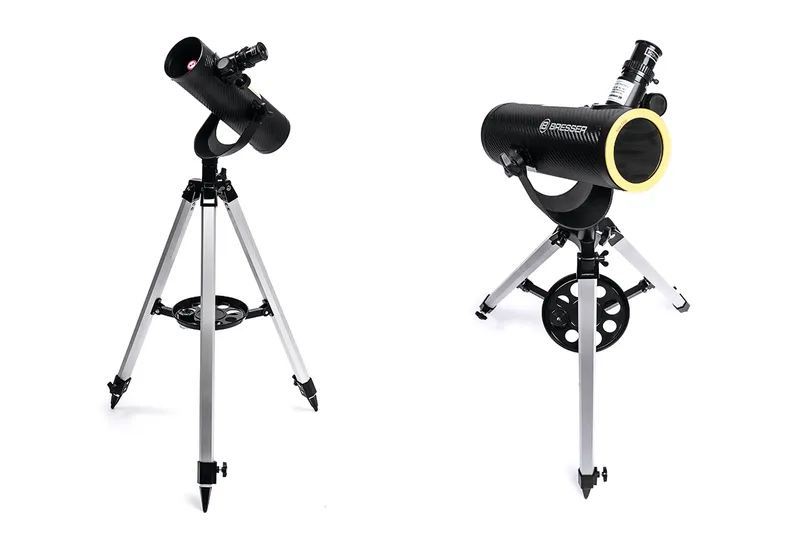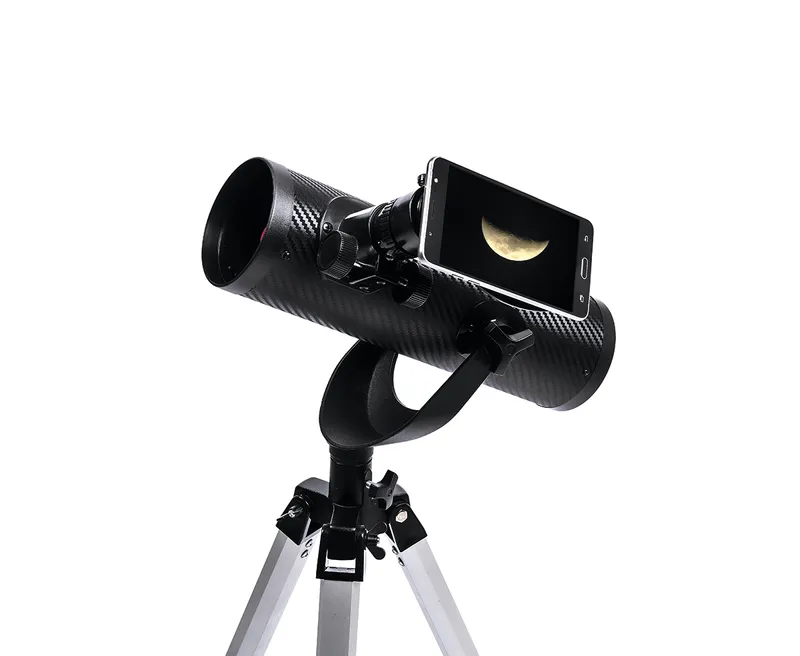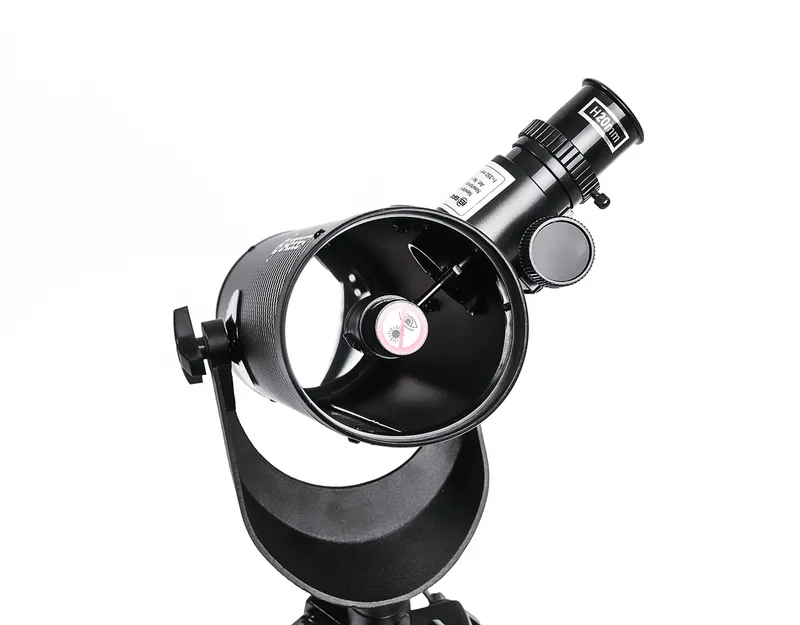The Bresser Solarix 76/350 telescope is an interesting, multi-purpose offering.
It’s aimed at beginners who want to try out some of the different aspects of astronomy while only buying one piece of equipment that doesn’t break the bank.
The Bresser Solarix 76/350 telescope is comprised of a 3-inch (76mm) Newtonian reflector on top of an aluminium tripod with a manual push-to mount.
This combination makes for a small and light unit once it’s been assembled.
A decent collection of accessories is bundled with the telescope, including 20mm and 4mm eyepieces, a 2x Barlow lens, a smartphone adapter and a certified solar filter.
The only omissions are a finderscope and a finder bracket on the telescope to allow you to install your own.
But, due to the Solarix having a large field of view, it’s possible (even without a finder) to aim it by using the 20mm eyepiece for the lowest magnification and sighting along the length of the telescope tube.

Setting up the Bresser Solarix 76/350 telescope
Setting up is quick and easy.
The few parts all fit together nicely and take only a minute or two to assemble without tools.
The Bresser Solarix 76/350 telescope's small size and low weight also make it easy to transport to dark-sky sites.
Its instructions come in two booklets: one is a generic telescope set-up manual, the other explains solar use and safety.
Converting for solar observing
Converting the Bresser Solarix 76/350 telescope to solar use is simple – all you need to do is attach the front-mounted solar filter.
As with all solar observing, caution is strongly advised.
Equipment (in particular the solar filter) should always be carefully inspected before use.
Once correctly fitted to the apparatus, it should only be used in the prescribed manner as detailed in the manual and you should never look at the Sun without the proper protective measures in place.
Together, the solar-use instruction manual and the many safety stickers on the Solarix do a good job of informing you how to go about safely observing the Sun.
A welcome addition would have been a protective cover for the solar filter, though.
Want to observe a solar eclipse? Find out when the next eclipse is taking place.

Smartphone astrophotography
By using the provided smartphone photo adaptor, simple astrophotography is also possible with the Solarix.
The adapter amounts to a sucker pad that holds your smartphone and attaches to the focuser.
The suckerpad isn’t 100% guaranteed to retain your phone when in use, so it’s a good idea to also use a lanyard to tie your smartphone down with.
You can loop the free end around the telescope’s focus tube.
How it performs
Our first test for the Bresser Solarix 76/350 telescope was observing the Moon.
Using the 20mm eyepiece provided a rich iew of the full lunar disc, showing good detail in the craters and along the terminator.
Once the eyepiece was swapped for one of a higher power, however, the Solarix’s weakness came to light: collimation.
Since only the secondary mirror is provided with collimation screws, it’s difficult to get the optics fully lined up.
This made many of the higher power magnifications almost unusable; flaring of the objects in the eyepiece was a common occurrence, as was an inability to find sharp focus at higher magnifications.
This was especially evident while observing Venus and Mars on the same evening.
Solar observations echoed the lunar and planetary experiences with decent views of the Sun’s disc at lower powers, but distorted views, once again, when higher magnifications were used.
Switching to deep space, nice views of the Orion Nebula (M42), the Pleiades (M45), the Andromeda Galaxy (M31) and the Double Cluster (NGC 869 and 884) were all possible.
The wide field of view at low magnification was just right to frame the deep-sky objects in their entirety.
Using the Solarix for astrophotgraphy produced a similar experience to observation
Good results were possible at low magnification, such as on the Sun or Moon, but the results were not so good at higher magnifications.
As such, we’d recommend using low magnification for most purposes.
The Solarix is a decent attempt at an affordable, all-round telescope package even though it’s marred by collimation issues that make it difficult to achieve sharp detail at higher magnifications.
It’s perhaps best suited to beginners or children – anyone looking for a telescope with which to take their first steps into the world of astronomy.

Multi-purpose
For curious beginners, the best type of scope is often a good, multifaceted telescope that will enable them to try a range of astronomical techniques, so as to see where their interests may lie.
The Solarix 76/350 is just such a scope, offering budding astronomers the chance to experience lunar, planetary, deep-sky and solar observation and take pictures using a smartphone.
The Solarix does all of these without the need to purchase any further equipment as many of the necessary extras are included in the relatively low price.
This should encourage more people to take the plunge without worrying about having to spend too much money trying things out before making any larger purchases.
If you’re buying for a child it would also be a good choice as its many features should keep them interested and busy for hours.
Small enough to sit on a balcony, light enough to travel anywhere easily, quick to set up and simple to use, the Solarix 76/350 is great as an introductory-level, multi-purpose system, even if it does have a
few collimation issues.
Best features
Optics
The Solarix is a 3-inch Newtonian reflector with a short focal length of 350mm, giving a focal ratio of f/4.6. It uses a single-arm strut to hold the secondary mirror.
When collimated, the Solarix gives good views at low magnifications, with only a small amount of the coma usually associated with Newtonian telescopes.
Focuser
The Solarix is fitted with a single-speed rack and pinion focuser that has adequate strength to hold all the equipment in place.
Even with the addition of the photo mount and a large smartphone, the focuser was solid enough to take steady pictures of the Moon without the focus shifting at any time.
Push-to fork mount
With a similar action to that of a Dobsonian mount, the push-to altaz fork mount is easy to use.
Large knobs on the sides of the fork and at the base of the mount are used for adjusting the mount head and telescope.
Tripod with accessories tray
The Solarix sits on an aluminium tripod that comes with a useful screw-on accessory tray to keep the various bits handy.
The tripod is height adjustable, lightweight and strong, all of which makes the whole assembly easy to transport.
Smartphone Mount
The smartphone mount has a separate elastic loop that helps to secure your phone. The mount is easy to install, you just slide it onto the focuser, insert an eyepiece and press your smartphone onto the pad with the camera’s lens directly over the lens of the eyepiece.
Fine tuning is achieved by moving the whole photo mount up and down the eyepiece barrel.
Vital stats
- Price: £75
- Optics: 76mm (3 inches)
- Focal Length: 350mm (f/4.6)
- Extras: 4mm and 20mm eyepieces, 2x Barlow lens, solar filter, smartphone photo adaptor, accessory tray
- Weight: 2.5kg
- Supplier: Telescope House
- www.telescopehouse.com
- Tel: 01342 837098
This telescope features in our lists of the best solar telescopes and best budget telescopes.
This review originally appeared in the April 2017 issue of BBC Sky at Night Magazine.